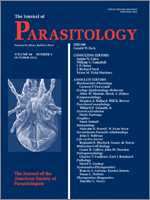The establishment of cat- and dog-derived laboratory strains of Ancylostoma braziliense allowed for a morphological comparison of the eggs of A. braziliense, Ancylostoma caninum, and Ancylostoma tubaeforme. The length, width, and perimeter were determined for images of 10 eggs each of A. braziliense from the feces of a dog infected with a canine isolate and a cat infected with a feline isolate, A. caninum from dog feces, and A. tubaeforme from cat feces. The specific identity of the eggs was verified by polymerase chain reaction and restriction fragment length polymorphism by using HinfI and RsaI restriction digests followed by gel electrophoresis and sequencing. The mean (±SD) length, width, and perimeter and the length-to-width ratio (±SD) (all measurements are in micrometers) for the eggs of each species were as follows: A. braziliense eggs (combined cat and dog source), 53.03 ± 2.33, 36.37 ± 1.35, 140.43 ± 2.56, and 1.46 ± 0.11; A. caninum eggs, 63.92 ± 5.28, 39.21 ± 1.52, 161.99 ± 9.30, and 1.63 ± 0.13; and A. tubaeforme eggs, 61.44 ± 3.05, 39.14 ± 1.40, 157.98 ± 5.81, and 1.57 ± 0.08. The eggs of A. braziliense were significantly (P < 0.001) smaller than the eggs of A. caninum and A. tubaeforme in all dimensions. Thus, the eggs seem to be readily distinguishable using light microscopy, thereby aiding in species identification in fecal samples for a more comprehensive clinical picture and assessment of zoonotic risk.
How to translate text using browser tools
1 October 2012
Morphological Differentiation of Eggs of Ancylostoma caninum, Ancylostoma tubaeforme, and Ancylostoma braziliense From Dogs and Cats in the United States
Araceli Lucio-Forster,
Janice L. Liotta,
Joseph P. Yaros,
Kaitlyn R. Briggs,
Hussni O. Mohammed,
Dwight D. Bowman
ACCESS THE FULL ARTICLE

Journal of Parasitology
Vol. 98 • No. 5
October 2012
Vol. 98 • No. 5
October 2012




